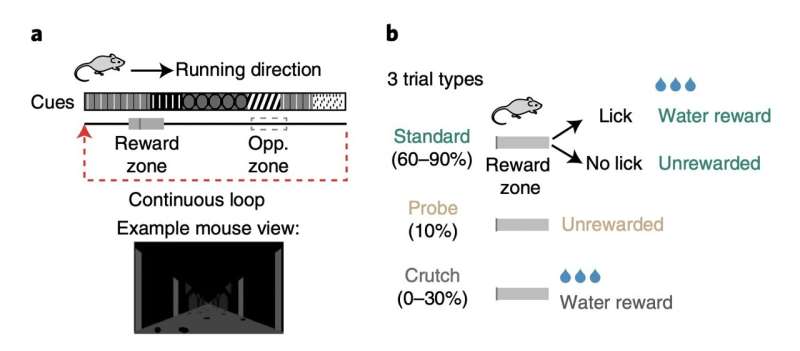May 18, 2022feature
Study shows that behavioral engagement could affect hippocampal place codes

The hippocampus is a region of the brain known to the associated with memory, learning, spatial navigation and emotion. In 1971, neuroscientists discovered that the hippocampus influences spatial navigation through the formation of a series of "spatial codes," which encode characteristics related to an animal or human's surrounding environment, including sensory cues and where rewards are located.
These codes are encoded by a type of neurons known as "place cells," which were found to become active when an animal is entering a specific place or location in itsenvironment. Together, place cells in the hippocampus form representations of the places that animals are navigating, also known as cognitive maps.
Since place cells were first uncovered, numerous teams worldwide have been conducting studies aimed at better understanding their function and how they encode spatial information. While there is now a large body of research focusing on place cells, some of the factors influencing their functioning are still poorly understood.
Researchers at Harvard Medical School have recently found that an animal's behavioral engagement with its surrounding environment can impact the spatial map created by place cells in the hippocampus. Their findings, published inNature Neuroscience, specifically show that when mice disengage from a navigation task, the quality of the spatial map relative to the environment they're in decreases.
Studies have found that place cells emerge before an animal has learned specific features of their surrounding environment. Therefore, some neuroscientists have proposed that place cells automatically form their 'spatial codes', by combining sensory and self-motion cues.
In their study, the researchers at Harvardmedical schooltested this hypothesis by training mice to navigate a virtual track, where they could lick in a specific location to receive water. The team observed that while the mice were engaged in the task and highly motivated to find the water their placecellswere engaged in a high amount of spatial coding. Surprisingly, however, once they drank the water and were no longer engaged in the task, the spatial firing patterns deteriorated, even as the mice continued to move within their environment.
"As animals explore an environment, the hippocampus is thought to automatically form and maintain a place code by combining sensory and self-motion signals," Noah L. Pettit, Xintong C. Yuan, and Christopher D. Harvey, the researchers who carried out the study, told Medical Xpress. "Instead, we observed an extensive degradation of the place code when mice voluntarily disengaged from a virtual navigation task, remarkably even as they continued to traverse the identical environment."
The findings gathered by Pettit, Yian and Harvey suggest that an animal's internal states can affect spatial maps and re-organize hippocampal activity. Notably, this can happen even when an animal is navigating the environment in similar ways, thus when they are exposed to the same sensory and self-motion-related signals.
These surprising results could contribute to the current understanding ofplace cellsand of how they encodespatial informationwhile animals are engaged or disengaged in a particular reward-based task. In the future, the recent work by the team at Harvard Medical School may pave the way for new studies investigating the effects of behavioral engagement on spatial encoding in thehippocampus.
© 2022 Science X Network
















